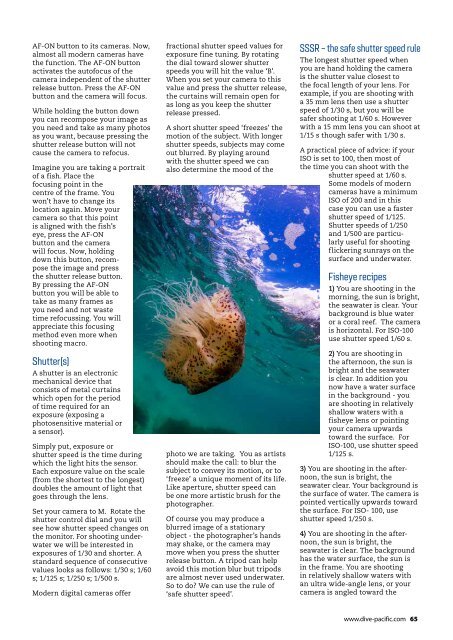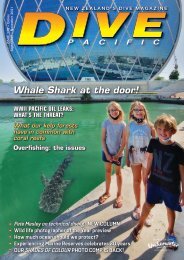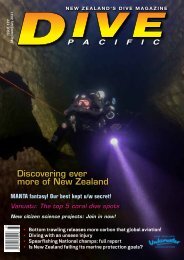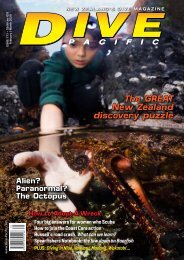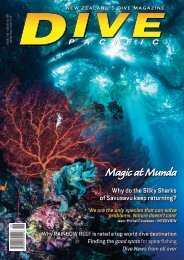Dive Pacific Iss 171 Oct- Nov 2019
New Zealand's dive magazine featuring in this issue: Shooting big sharks, up close; Spearfishing at night!; Remembering a great Kiwi dive pioneer, Wade Doak; Forgotten Vanuatu wreck's claim to fame; The invasive Lionfish - in depth, plus all our expert columnists
New Zealand's dive magazine featuring in this issue: Shooting big sharks, up close; Spearfishing at night!; Remembering a great Kiwi dive pioneer, Wade Doak; Forgotten Vanuatu wreck's claim to fame; The invasive Lionfish - in depth, plus all our expert columnists
Create successful ePaper yourself
Turn your PDF publications into a flip-book with our unique Google optimized e-Paper software.
AF-ON button to its cameras. Now,<br />
almost all modern cameras have<br />
the function. The AF-ON button<br />
activates the autofocus of the<br />
camera independent of the shutter<br />
release button. Press the AF-ON<br />
button and the camera will focus.<br />
While holding the button down<br />
you can recompose your image as<br />
you need and take as many photos<br />
as you want, because pressing the<br />
shutter release button will not<br />
cause the camera to refocus.<br />
Imagine you are taking a portrait<br />
of a fish. Place the<br />
focusing point in the<br />
centre of the frame. You<br />
won’t have to change its<br />
location again. Move your<br />
camera so that this point<br />
is aligned with the fish’s<br />
eye, press the AF-ON<br />
button and the camera<br />
will focus. Now, holding<br />
down this button, recompose<br />
the image and press<br />
the shutter release button.<br />
By pressing the AF-ON<br />
button you will be able to<br />
take as many frames as<br />
you need and not waste<br />
time refocussing. You will<br />
appreciate this focusing<br />
method even more when<br />
shooting macro.<br />
Shutter(s)<br />
A shutter is an electronic<br />
mechanical device that<br />
consists of metal curtains<br />
which open for the period<br />
of time required for an<br />
exposure (exposing a<br />
photosensitive material or<br />
a sensor).<br />
Simply put, exposure or<br />
shutter speed is the time during<br />
which the light hits the sensor.<br />
Each exposure value on the scale<br />
(from the shortest to the longest)<br />
doubles the amount of light that<br />
goes through the lens.<br />
Set your camera to M. Rotate the<br />
shutter control dial and you will<br />
see how shutter speed changes on<br />
the monitor. For shooting underwater<br />
we will be interested in<br />
exposures of 1/30 and shorter. A<br />
standard sequence of consecutive<br />
values looks as follows: 1/30 s; 1/60<br />
s; 1/125 s; 1/250 s; 1/500 s.<br />
Modern digital cameras offer<br />
fractional shutter speed values for<br />
exposure fine tuning. By rotating<br />
the dial toward slower shutter<br />
speeds you will hit the value ‘B’.<br />
When you set your camera to this<br />
value and press the shutter release,<br />
the curtains will remain open for<br />
as long as you keep the shutter<br />
release pressed.<br />
A short shutter speed ‘freezes’ the<br />
motion of the subject. With longer<br />
shutter speeds, subjects may come<br />
out blurred. By playing around<br />
with the shutter speed we can<br />
also determine the mood of the<br />
photo we are taking. You as artists<br />
should make the call: to blur the<br />
subject to convey its motion, or to<br />
‘freeze’ a unique moment of its life.<br />
Like aperture, shutter speed can<br />
be one more artistic brush for the<br />
photographer.<br />
Of course you may produce a<br />
blurred image of a stationary<br />
object - the photographer’s hands<br />
may shake, or the camera may<br />
move when you press the shutter<br />
release button. A tripod can help<br />
avoid this motion blur but tripods<br />
are almost never used underwater.<br />
So to do? We can use the rule of<br />
‘safe shutter speed’.<br />
SSSR – the safe shutter speed rule<br />
The longest shutter speed when<br />
you are hand holding the camera<br />
is the shutter value closest to<br />
the focal length of your lens. For<br />
example, if you are shooting with<br />
a 35 mm lens then use a shutter<br />
speed of 1/30 s, but you will be<br />
safer shooting at 1/60 s. However<br />
with a 15 mm lens you can shoot at<br />
1/15 s though safer with 1/30 s.<br />
A practical piece of advice: if your<br />
ISO is set to 100, then most of<br />
the time you can shoot with the<br />
shutter speed at 1/60 s.<br />
Some models of modern<br />
cameras have a minimum<br />
ISO of 200 and in this<br />
case you can use a faster<br />
shutter speed of 1/125.<br />
Shutter speeds of 1/250<br />
and 1/500 are particularly<br />
useful for shooting<br />
flickering sunrays on the<br />
surface and underwater.<br />
Fisheye recipes<br />
1) You are shooting in the<br />
morning, the sun is bright,<br />
the seawater is clear. Your<br />
background is blue water<br />
or a coral reef. The camera<br />
is horizontal. For ISO-100<br />
use shutter speed 1/60 s.<br />
2) You are shooting in<br />
the afternoon, the sun is<br />
bright and the seawater<br />
is clear. In addition you<br />
now have a water surface<br />
in the background - you<br />
are shooting in relatively<br />
shallow waters with a<br />
fisheye lens or pointing<br />
your camera upwards<br />
toward the surface. For<br />
ISO-100, use shutter speed<br />
. 1/125 s.<br />
3) You are shooting in the afternoon,<br />
the sun is bright, the<br />
seawater clear. Your background is<br />
the surface of water. The camera is<br />
pointed vertically upwards toward<br />
the surface. For ISO- 100, use<br />
shutter speed 1/250 s.<br />
4) You are shooting in the afternoon,<br />
the sun is bright, the<br />
seawater is clear. The background<br />
has the water surface, the sun is<br />
in the frame. You are shooting<br />
in relatively shallow waters with<br />
an ultra wide-angle lens, or your<br />
camera is angled toward the<br />
www.dive-pacific.com 65


